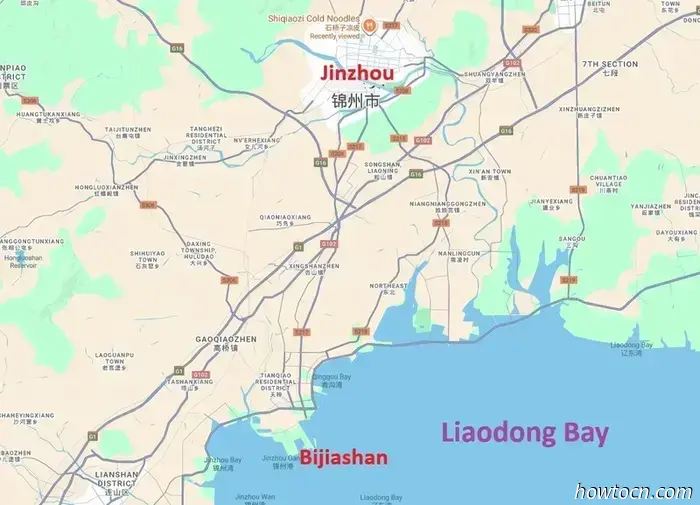
I carefully selected our day trip from Jinzhou to ensure it offered more than just beautiful views. Bijiashan is a small island located off the Liaoning coast, about an hour south of Jinzhou's city center. The name Bijiashan translates to "pen holder mountain," reflecting the island's resemblance to the little platform used for resting a calligraphy pen. As usual, Mei Ling arranged for one of our taxi drivers to take us there at a fair price, though we didn't keep him for the entire day. He dropped us off at a square about a block from the shore, bustling with restaurants and shops selling beach supplies to domestic tourists. We made our way to the seaside promenade, which featured large concrete statues of Fu Xi and Nüwa, revered figures from Chinese mythology known for their creation of humanity.
From the water's edge, we admired the island's profile, a steep hill emerging from the sea with two peaks. The gap between them distinctly resembled an ideal resting place for a giant pen. A dirt and sand path extended into the bay towards the island, disappearing into the surf. At low tide, visitors can walk across the land bridge to Bijiashan, but we had missed it. Instead, we would take one of the many speedboats racing through the shallow water near the beach. There was no need to negotiate, as Mei Ling had already purchased our boat tickets along with access to the island at a kiosk on the promenade.
Once we arrived at the island, we immediately started a steep ascent up the mountain. The paths were lined with stalls selling snacks and souvenirs. After sweating profusely in the midday heat, we finally reached the first peak, where we could see the Sanqing Pavilion. This remarkable structure was built in the early twentieth century to honor the Three Pure Ones of Taoism. Spiral staircases wrapped around the building's exterior with visitors gathered on the top level. Climbing the stairs seemed easy from below, but once on them, I realized the railings were uncomfortably low, only reaching the bottom of my thighs. The boys fared better, but the stairs were crowded, and some tourists were a bit pushy. I kept Ian and Spenser close to me and urged them to stay toward the inside, mindful of the protruding masonry that could hit me on the head as I climbed, despite my shorter stature. We made it safely to the top and enjoyed views of the temple grounds and the peak we had descended.
In the courtyard below the tower stood a large bronze incense burner decorated with dragon relief patterns symbolizing transformation. On either side of it were wooden masts for holding lanterns or banners during ceremonies. We followed a staircase down to another courtyard that featured a large cauldron signifying spiritual cleansing, part of a Buddhist temple often found alongside Taoist and Confucianist structures. In the adjoining prayer hall, the Three Buddhas of the Three Worlds represented enlightenment in the past, present, and future. The path continued along the island's long axis, ascending to the second peak before descending again to a small hexagonal pavilion overlooking the bay. After considering the effort required to climb back up the staircase in the sweltering heat, we opted to skip this final section. The views from where we stood weren't bad, despite the massive fuel storage facility occupying the nearby mainland.
We returned to the first summit where a small tower dedicated to Lü Dongbin, one of the Eight Immortals in Taoism, stood. Local legend says it was Lü Dongbin who left a dent in the mountain with his giant calligraphy pen. The granite staircase led to an upper section intended for meditation or viewing. From there, we took a long staircase that descended nearly to the base of the mountain, bypassing most tourist stalls.
At the mountain's base, I walked onto a long pier where fishermen, dressed in clothing covering almost every inch of their skin, were trying to catch sardines, though they seemed to be having little success. After a few moments, the boys joined me, and we admired the distinctive slanted triangular shape of the mountain we had just climbed. The island had its end of the disconnected causeway, a swirl of rocks and sand that ended despondently in the rising tide. Boats continued to arrive to take tourists back to the mainland, and we didn't wait long before boarding. A few minutes later, we were back at the promenade, looking once more at the pen holder mountain.
Fu Xi and Nüwa were right where we had left them. Nüwa's outstretched hands represented her creative force, which she used to mend the heavens and protect humanity. Our Bijiasan tickets also provided access to a reptile house, featuring a variety of snakes and lizards in somewhat worn enclosures. One potbellied green frog clung to the glass wall of its tank, next to a placard of the controversial cartoon character Pepe,





























I selected our day trip from Jinzhou thoughtfully to ensure it offered more than mere scenic views. Bijiashan is a small island located just off Liaoning's coast, roughly an hour to the south of Jinzhou's city center. The name Bijiashan translates to "pen holder mountain," which alludes to the resemblance of the island's shape to the small stand used to rest a calligraphy pen. As was customary, Mei Ling had coordinated with one of our taxi drivers to take us there at a fair rate, although we did not keep this driver for the entire day.